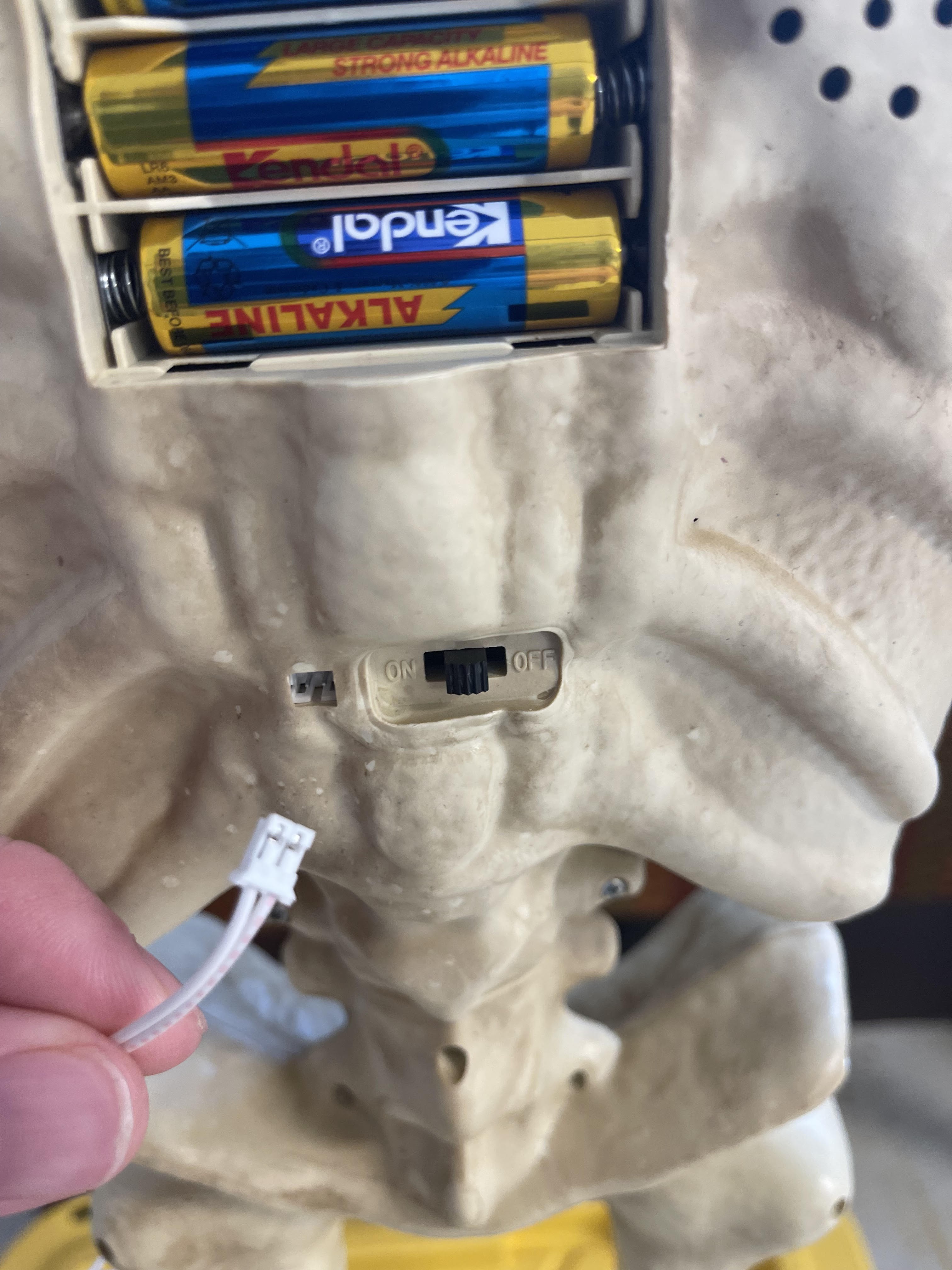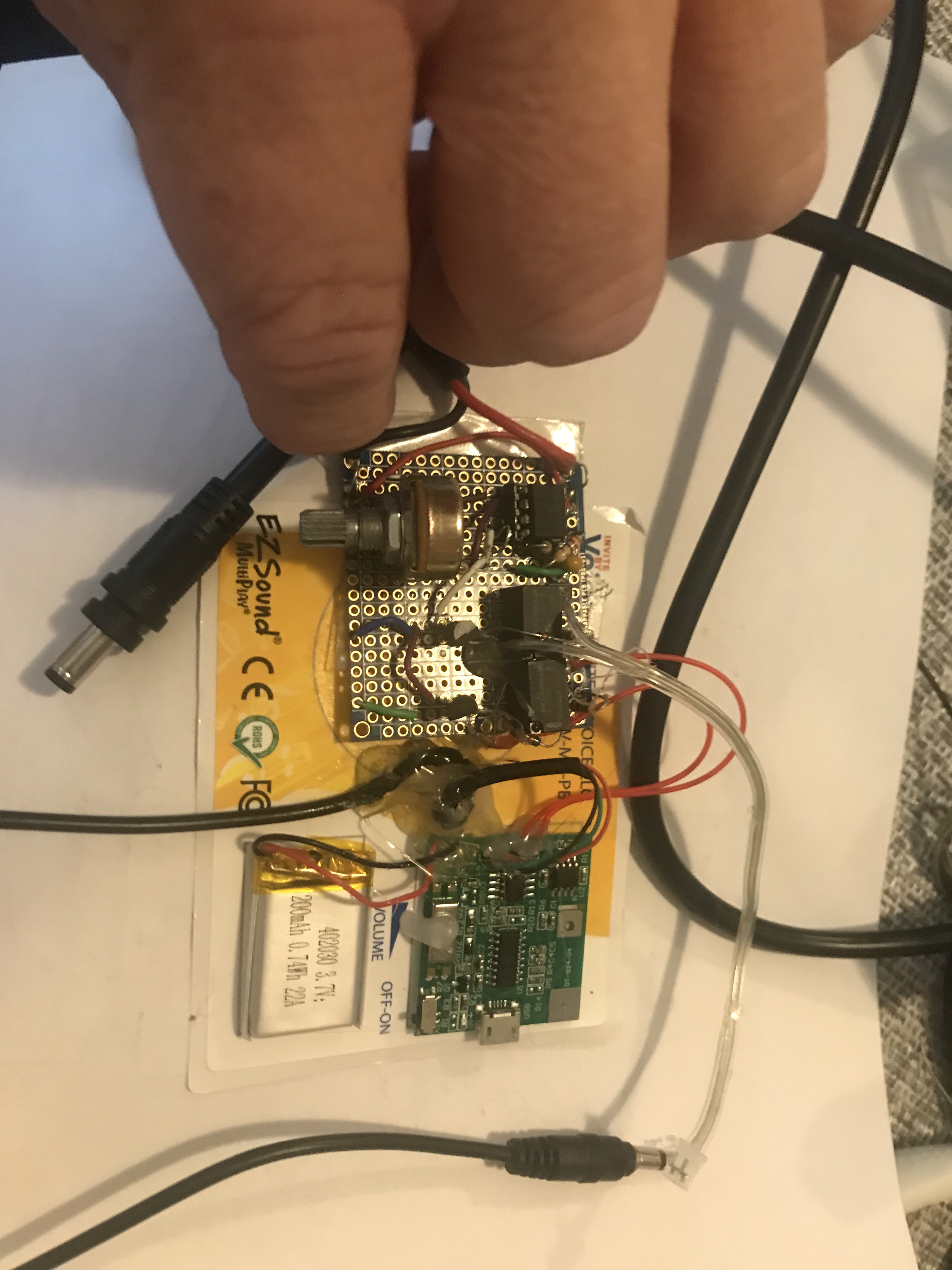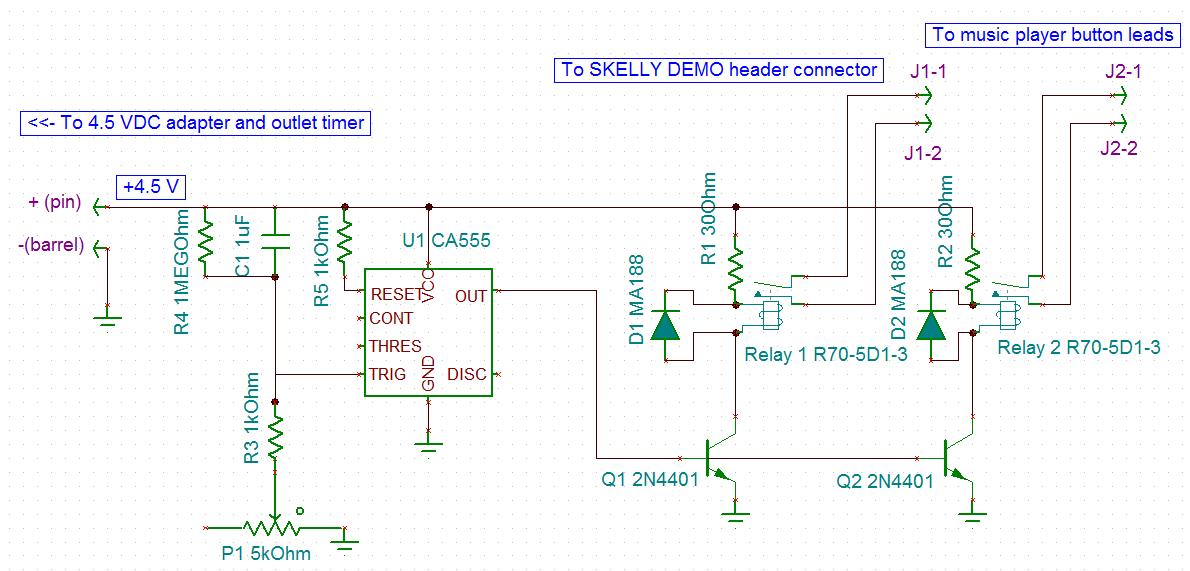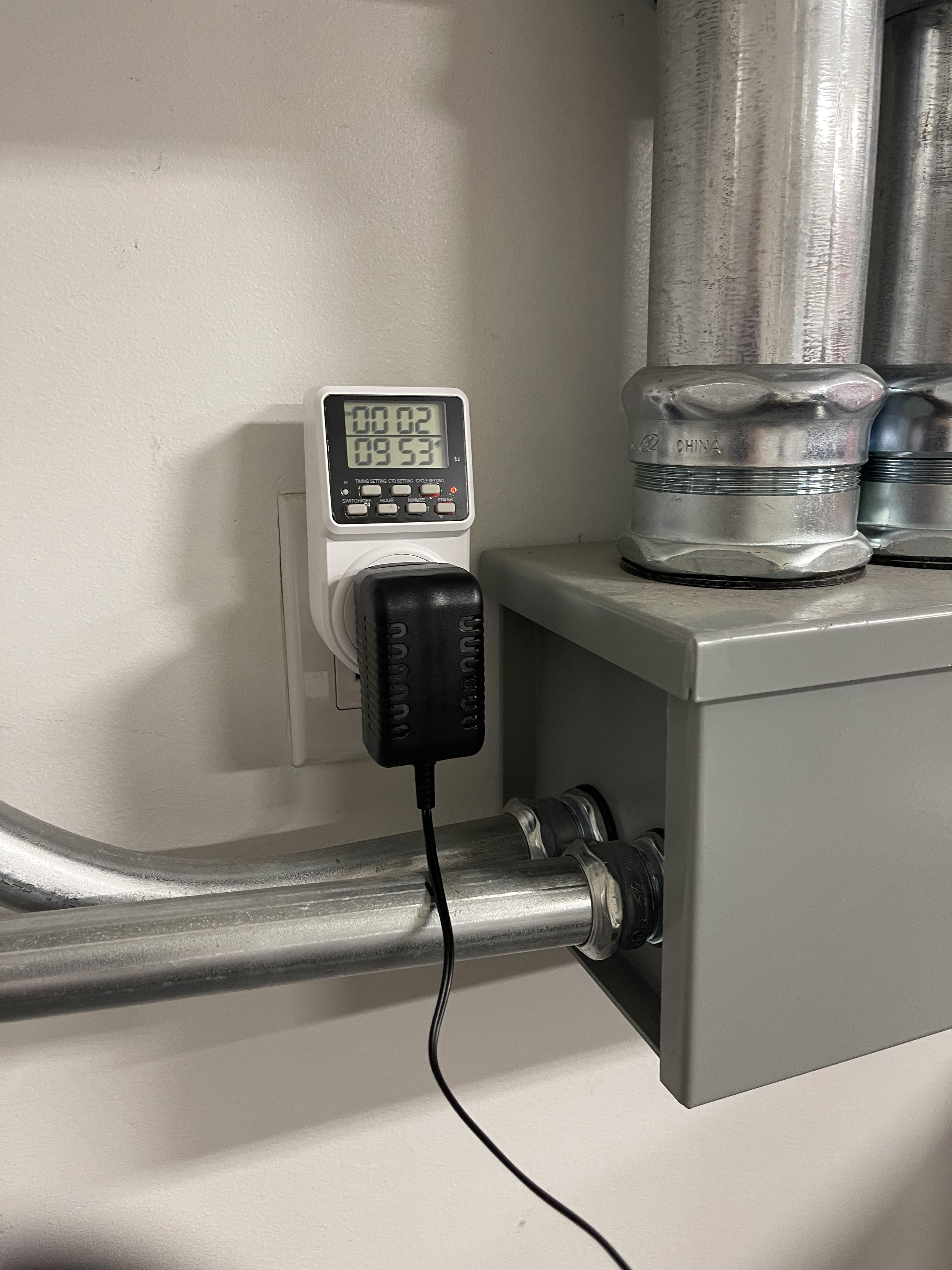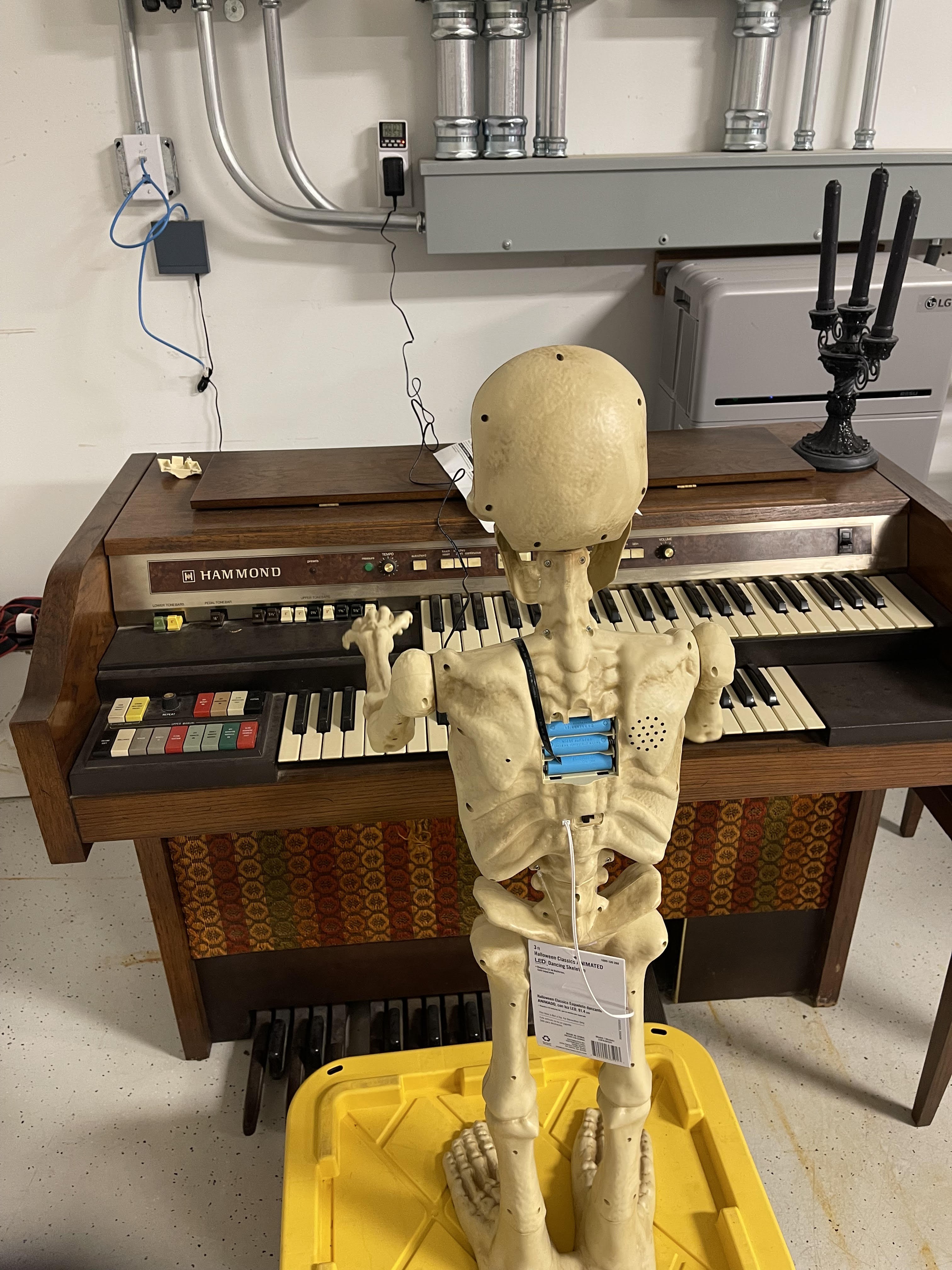-
Presentation
10/29/2023 at 19:37 • 0 commentsThe final product, draped with a purple cape and accompanied by sound-activated lights. It made a lovely centerpiece for a Halloween-themed party.
This was a very satisfying project for me, as it achieved the effect much as planned, was not overly expensive, and was completed on time. So few of my projects are actually finished. Thanks for reading!
-
Project Integration
10/28/2023 at 21:45 • 0 commentsWe now had a timer, power supply, splitter, controller board, a SKELLY, and a music player. The button on the music player was clipped off and the leads soldered to the control board. The leads were short and the controller had to be physically close to the music player.
![]()
Above, the DEMO button connector pulled out of the back of SKELLY. This sort of keyed two-pin header seems to be pretty commonly used for DEMO switches on consumer products. I happened to have an identical one on short leads that I soldered onto the controller board.
The music player originally was four components stuck to a big sticker by double-sided foam tape. Once the speaker was clipped and peeled off there was room for the control board, which was also taped onto the big sticker.
The completed controller/music board looked like this:
This photo is a little visually confusing, but the power connector is at the top, then the black connector on the bottom is just a 1/8-inch audio plug (an AUX cord end), and the little thing obscuring the audio plug is the header connector that plugs into SKELLY.
Note the generous use of hot glue to secure fragile leads. Mechanical robustness is easy to forget in electronics projects. Although hardly an "extreme" environment, there would be stresses, and reliability was important.
We decided the sticker with control board would be securely taped to the back of SKELLY with double-sided foam tape. This accommodated the short leads to the DEMO connector and was easily hidden by the planned-upon clothing.
placeholder
Here one can see the control board + music player taped to the back of SKELLY, along with the battery adapter, the power cord, the organ and a black candlestick. The AUX-style cord is plugged into an extender which went to a much bigger amp than originally planned, improving the volume and bass wonderfully. There is a piece of tape covering the speaker on the back of SKELLY in an attempt to muffle the awful music endemic to the animatronic ("Come on all you ghouls/ Dance around like fools..."). The tape was not effective enough, so MIBRO eventually just opened up SKELLY and cut the wires to the internal speaker. -
Why Relays?
10/28/2023 at 21:42 • 0 commentsI feel this might be a good point to discuss (read:defend) my choice to use relays.
![]()
Above, some other 3V relays that were physically larger that I also got but didn't use. Inserted for visual interest.
I desired to keep the consumer products electrically isolated from any control circuitry so as to avoid complications caused by interactions and differing voltages. Both SKELLY and the audio unit were designed to be activated by pushbuttons. The crudest solution would be a solenoid that physically pushed the button with a plunger when activated. Although not impossible, this solution is appallingly inelegant and would require more energy than any other sensible solution.
Relays are slow, they require significant energy, and the coil requires a snubber circuit to prevent damage from inductive kickback/ back EMF when de-energized. However, they are cheap, available, reliable, and provide excellent electrical isolation. The switches on a relay may suffer from some mechanical chatter, but they are very low resistance and can handle a wide range of voltages and currents.
The desire for electrical isolation eliminates most transistor- or SCR-type switching with the exception of optoisolators (optocouplers, photocouplers). These devices look like integrated circuits but are really a LED paired with a photodiode, phototransistor, or other photosensitive active component. When one circuit lights the LED, the circuit on the other side is affected by the light striking the photosensitive component. Thus the two circuits are electrically isolated up to hundreds or even thousands of volts, with only light energy passing between them. Most optocouplers do not handle a lot of current and become derated quickly, but could be used to switch a more capable transistor.
So the switches could be replaced by optically-activated transistors. I abashedly must admit that my transistor knowledge is somewhat lacking, but even a favorite like a 2n2222 or 2n7000 has a significant voltage drop or ohmic resistance when "fully on", which is a bummer. Knowing what sort of switch resistance is tolerated in the consumer circuits requires significant analysis or experimentation. Then again, a 2n2222 driven into saturation only has a voltage drop of .3-1.0V and an "on" 2n7000 has a resistance of no more than 5.3Ω with 4.5V between gate and source.
I used little black relays instead of big blue relays because they were smaller. I also wish to gripe one more time: WHY is it that no relay fits properly onto a breadboard? I daresay no relay that I have can go into a breadboard without shorting pins or jamming a pin in the middle trough.
-
Controller
10/07/2023 at 03:59 • 0 commentsSo SKELLY required an activation "button press" very shortly after power was supplied. This meant a delay, so I reached for every hobbyist's favorite timer, the 555 IC. It had been a very long time since I had messed with a 555 timer IC, so I reviewed it, and quickly understood why the chip is so popular. In brief, when the voltage on the TRIGGER input falls below 1/3VCC, the output switches HIGH, and when the voltage on the THRESHOLD input goes above 2/3VCC, the output goes LOW and the open-collector DISCHARGE pin shorts to ground. There are many many ways to hook up various RC circuits to this to perform all kinds of tasks.
The relays I obtained ran on 3 V so that they could be energized with the 4.5 V power source for SKELLY (with appropriate current reduction). I had assumed that the 555 timers I obtained would be able to drive the relays directly, but no such luck-- the IMC7555 CMOS chip I obtained had very flexible voltage requirements, but could only source/sink 1.0mA/3.2mA respectively.
I had a BJT transistor lying around and found it could drive the relay just fine, triggered by the 555 output. Examination proved the transistor to be a NPN (yes, I didn't bother checking first) 2N4401 . I found a second one nearby so this became my official transistor. Would a MOSFET be better? Well, the voltage control would probably make it a little more complicated.
![]()
The schematics for the simple control board are shown above. The control board is energized only when the outlet timer turns on, switching on the 4.5VDC adapter. The 555 timer is wired to turn on for an indefinite period after a brief delay. The RESET input is tied HIGH to prevent resetting the internal flip-flop. C1 and R3 + P1 form a time-dependent voltage divider: C1 is empty when power is supplied, which will cause the voltage at the 555's TRIGGER input to start high and eventually fall to zero. The variable resistor allows some adjustment of the delay time.
As soon as the TRIGGER input falls below 1/3 VCC (about 1.35 V), the OUT pin goes HIGH, switching on both transistors Q1 and Q2. This then pulls current through the respective relay coils, closing the switches. The resistors drop the voltage to the rated 3V.
The first relay is connected to the DEMO button header on SKELLY and substitutes for the DEMO button. The second relay is soldered in place of the button that activates the music player. Hence both SKELLY and the music start at the same time, but shortly after the DC adapter switches on.
When the power switches off, the relay coils generate a flyback voltage. D1 and D2 short this voltage to prevent damage to other components. The charge on C1 is allowed to drain through the 1 Megohm resistor, which is high enough not to interfere with the short-term timing, but allows discharge over the several minutes before the next turn-on.
To be brutally honest, I don't recall the exact values of the resistors I used, but they were similar to the values listed. The current through the coils was lower than expected, but they snapped closed with no trouble.
The control board was soldered up on some perfboard that was NOT identical to a breadboard. I might have been tempted to keep it on a breadboard, but neither these relays nor the alternative relays I had handy would fit properly on a breadboard. I'm unsure why electronics manufacturers decided this would be a great way to do things.
I soldered a barrel connector onto the perfboard. This was intended to connect to the splitter for a convenient way to direct power to both SKELLY and the control board without wrecking cables or soldering/crimping. Unfortunately, I picked the wrong cable "sex", but MIBRO had a male-to-male adapter that saved the day.
Why relays? See next log.
-
Powering Up Skelly
10/07/2023 at 03:56 • 0 commentsWhen MIBRO and I realized our mistake in purchasing the wrong power supply, he returned the first one and bought this one. MIBRO also bought these splitters to simplify tapping into the power supply to activate the sound relay.
![]()
Above, timer and power supply. Below, plugged into SKELLY.
![]()
MIBRO then plugged this new power supply into his sophisticated timer, put the dummy batteries into SKELLY's back, left SKELLY's power switch in the ON position, and then let the timer activate.
Nothing. Apparently silently turning on the power did not result in "dancing".
If the DEMO button was pressed immediately after being powered, SKELLY would dance for the full 30 seconds. However, permanently shorting the DEMO button and leaving the switch in the ON position did NOT result in SKELLY dancing when the power was turned on. Apparently, the DEMO button had to be pressed just after powering on.
Now the parameters of the control electronics were clear. Just after being supplied power, a relay would close to substitute for the DEMO button on SKELLY. At the same time, another relay would close to "press the button" on the sound module.
-
Modifying the Sound Unit
10/07/2023 at 03:16 • 0 commentsMy brother (MIBRO) loaded a 29-second clip of Toccata and Fugue in D Minor onto the little sound player. He was pleased with the playback quality, but we both knew it the sound would have to be amplified for sufficient spookiness.
I clipped off the little speaker and tried to measure the max levels on an oscilloscope. My goal was not to exceed 0.3V. This was difficult, as the dynamic range was quite wide. Eventually I just soldered a chunk of AUX cord with 1/8 in audio plug on the end to where the speakers had connected. It was a stereo plug, so I soldered both channels to one side and return to the other.
I then plugged this in to an old iPhone dock with nice speakers that MIBRO had provided. I turned up the volume on the little sound unit as high as I dared without noting any distortion. I then hot-glued the volume in place to prevent damage and distortion.
When I hit the button, the Sound Unit played the music. Holding the button down didn't cause any trouble, so substituting a relay for the switch would be straightforward-- that is, if the relay was just activated by the skeleton power supply going on, it wouldn't need a timer to switch it off before the music ended.
The little sound unit would charge just fine, but when I attempted to program another sound file into it (by hooking up the provided USB cable and turning it ON), the output would go to some DC voltage (like 2 or 3), the computer would not recognize the device, and the amplifier chip got hot. I don't understand how cutting off the speaker would cause this, but I am pretty sure that I wasn't shorting the output-- it was hooked to my O-scope.
Post Script: OHHHH. The O-scope was a computer one--- there was a hidden short when I connected the device to the computer and the computer oscilloscope to the device. I had encountered this once before. Observation affects the observed.
-
Music and the Motor
10/07/2023 at 03:04 • 0 commentsMy brother (MIBRO) enlisted my help to make a creepy figure appear to play the organ. He originally had planned to make a PVC torso rocked back and forth by a windshield wiper motor, powered by an adjustable power supply on a timer. The power supply was an AC-to-DC converter and the timer one of those that turns the mains current on and off.
After discussing the parameters of the project, we decided to purchase a sound player that could be loaded with a sound file and play it when a button was pressed. The button would then be replaced by a relay that would close when the power came on to move the torso. We settled on this sound player. It was not the least expensive but had decent ratings.
![]()
Note how everything is taped to a large sticker with double-sided foam tape. This is important later.
MIBRO came by to deliver the sound module to me for modification. While visiting me at A Certain Place, I pointed out a Dancing Skeleton decoration. This hideous little skeleton had bulging glowing blue eyes and arms that would wave up and down on alternate sides while it sang about ghouls dancing about like fools. The arms were quite poseable. This video (not mine) illustrates the action of the Dancing Skeleton (SKELLY). SKELLY is activated either by a DEMO button or by a sound sensor. More on this later.
![]()
Above, the skeleton animatronic (SKELLY) in its natural habitat.
The motion was perfect and it was half the price of the windshield wiper motor with power supply. MIBRO purchased it immediately.
 bryan.lowder
bryan.lowder